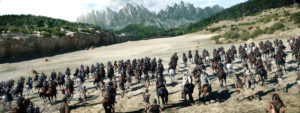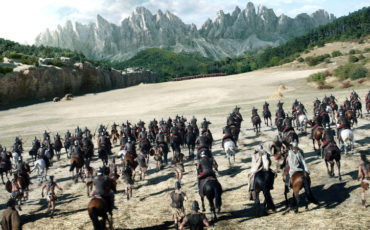
Press Release: Cinesite Creates Digital Carnage for Hercules Battle
Cinesite has completed visual effects for a major battle sequence in MGM/Paramount Pictures’ latest release, Hercules. Starring Dwayne Johnson in the title role, the film is directed by Brett Ratner, with VFX supervision by John Bruno and Dean Wright. Cinesite’s Visual Effects Supervisor was Simon Stanley-Clamp.
Having completed his legendary twelve labours, Hercules (Johnson), the Greek demigod, has his life as a sword-for-hire tested when the King of Thrace and his daughter seek his aid in defeating a tyrannical warlord.
In Cinesite’s 180 shot sequence, Hercules and his mercenaries have been hired by Cotys to help defeat Rhesus. The two armies meet in battle.
 In one early shot, as the camera flies over the empty battlefield, we see Mount Asticus rearing up in the background, before a massive army of charging marauders emerge over the brow of the hill. Led by soldiers on horseback, the soldiers kick up layers of dust which rise up into the air. This challenging shot was entirely computer generated.
In one early shot, as the camera flies over the empty battlefield, we see Mount Asticus rearing up in the background, before a massive army of charging marauders emerge over the brow of the hill. Led by soldiers on horseback, the soldiers kick up layers of dust which rise up into the air. This challenging shot was entirely computer generated.
The battle takes place in a region surrounded by forest, mountains and cliffs on all sides, which were added by Cinesite’s environment team. The forest was created using the Speedtree system, and in-house techniques were used to project digital matte paintings onto geometry to create environments which gave realistic parallax during camera movement.
The 100 extras were digitally expanded to create up to 10,000 CG soldiers. Motion capture footage of a variety of soldier actions was captured by Centroid, whose data was attached to our rigs. A combination of standalone and crowd animation techniques were used to create the final, epic shots. Digital horses were also added, as well as weapons and FX elements such as dust, flames and straw.
Throughout the course of the battle, hundreds of soldiers are killed and for continuity purposes it was necessary to create a dead body pass. One of the final shots in the sequence was created first, and the team worked backwards to introduce the bodies in the appropriate shots. The same practice was used for arrows, which needed to be seen to land and remain in the correct places in sequence order.




